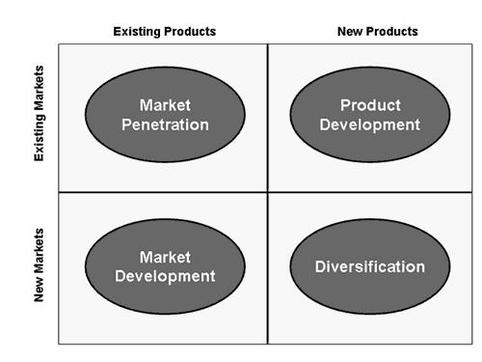ANSOFF’S MATRIXThe Ansoff Growth matrix is a tool that helps businesses decides their product and market growth strategy. Ansoff’s product/market growth matrix suggests that a business’ attempts to grow depend on whether it
markets new or existing products in new or existing markets. The output from the Ansoff product/market matrix is a series of suggested growth strategies that set the direction for the business strategy. These are described below: MARKET PENETRATION Market penetration is the name given to a growth strategy where the business focuses on selling existing products into existing markets. Market penetration seeks to achieve four main objectives: 1. Maintain or increase the market share of current products – this can be achieved by a combination of competitive pricing strategies, advertising, sales promotion and perhaps more resources dedicated to personal selling 2. Secure dominance of growth markets 3. Restructure a mature market by driving out competitors; this would require a much more aggressive promotional campaign, supported by a pricing strategy designed to make the market unattractive for competitors 4. Increase usage by existing customers – for example by introducing loyalty schemes. A market penetration marketing strategy is very much about “business as usual”. The business is focusing on markets and products it knows well. It is likely to have good information on competitors and on customer needs. It is unlikely, therefore, that this strategy will require much investment in new market research. MARKET DEVELOPMENT Market development is the name given to a growth strategy where the business seeks to sell its existing products into new markets. There are many possible ways of approaching this strategy, including: 1. New geographical markets; for example exporting the product to a new country 2. New product dimensions or packaging: for example 3. New distribution channels 4. Different pricing policies to attract different customers or create new market segments PRODUCT DEVELOPMENT Product development is the name given to a growth strategy where a business aims to introduce new products into existing markets. This strategy may require the development of new competencies and requires the business to develop modified products, which can appeal to existing markets. DIVERSIFICATION Diversification is the name given to the growth strategy where a business markets new products in new markets. This is an inherently more risk strategy because the business is moving into markets in which it has little or no experience. For a business to adopt a diversification strategy, therefore, it must have a clear idea about what it expects to gain from the strategy and an honest assessment of the risks. |
|
- Home
-
Applied Analytics
-
Analytics for Decision Making
>
- What is Cluster Analysis
- Data Reduction and Unsupervised Learning
- Preparing Data and Measuring Dissimilarities
- Hierarchical and k-Means Clustering
- Defining Output Variables and Analyzing the Results
- Using Historical Data to Model Uncertainty
- Models with Correlated Uncertain Variables
- Creating and Interpreting Charts
- Using Average Values versus Simulation
- Optimization and Decision Making
- Formulating an Optimization Problem
- Developing a Spreadsheet Model
- Adding Optimization to a Spreadsheet Model
- What-if Analysis and the Sensitivity Report
- Evaluating Scenarios and Visualizing Results to Gain Practical Insights
- Digital Marketing Application of Optimization
- Advanced Models for Better Decisions
- Business Problems with Yes/No Decisions
- Formulation and Solution of Binary Optimization Problems
- Metaheuristic Optimization
- Chance Constraints and Value At Risk
- Simulation Optimization
-
Analytics for Marketing
>
- Marketing Analytics and Customer Satisfaction
- Customer Satisfaction
- Measurements and Scaling Techniques – Introduction
- Primary Scales of Measurement
- Comparative Scaling
- Non-Comparative Scaling
- Experiment Design: Controlling for Experimental Errors
- A/B Testing: Introduction
- A/B Testing: Types of Tests
- ANOVA – Introduction
- Example -Inspect Spray and Tooth Growth
- Logit Model - Binary Outome and Forecastign linear regression
- Text Summarization
- Social media Microscope
- N-Gram - Frequcy Count and phase mining
- LDA Topic Modeling
- Machine-Learned Classification and Semantic Topic Tagging
- Data Engine >
-
Customer Insights
>
- Introduction
- What is Descriptive Analytics?
- Survey Overview
- Net Promoter Score and Self-Reports
- Survey Design
- Passive Data Collection
- Media Planning
- Data Visualization
- Causal Data Collection and Summary
- Asking Predictive Questions
- Regression Analysis
- Data Set Predictions
- Probability Models
- Results and Predictions
- Perspective Analytics (Maximize Revenue and Market Structure Competitions)
-
Analytics for Advance Marketing
>
- Visualisation and statistics (Political Advertising,Movie Theater and Data Assembly)
- Excel Analysis of Motion Picture Industry Data
- Displaying Conditional Distributions
- Analyzing Qualitative Variables
- Steps in Constructing Histograms
- Common Descriptive Statistics for Quantitative Data
- Regression-Based Modeling
- Customer Analytics
- Illustrating Customer Analytics in Excel
- Customer Valuation Excel Demonstration
-
Analytics for Decision Making
>
- Soft Skills
- Marketing
- Finance
-
Economics
- JBDON Golf
- Let's Talk
- MBA Project Sharing
-
About Us
-
Good Read
>
- IIMC says PepsiCo CEO Indra Nooyi was an average student
- India’s middle class figures in Fortune’s Top Ten list of those who matter
- The Start-Up of you.
- BUYING AND MERCHANDISING
- HUMAN RESOURCE MANAGEMENT
- Do You Suffer From Decision Fatigue?
- New Page
- About social media and web 2.0
- Building Your Own Start-up Technology Company, Part 1
- Building Your Own Start-up Technology Company, Part 2
- Building Your Own Start-up Technology Company, Part 3
- Building Your Own Start-up Technology Company, Part 4
- Renewable energy is no longer alternative energy
- What Makes an Exceptional Social Media Manager?
- The Forgotten Book that Helped Shape the Modern Economy
- Home
- How to Think Creatively
- A Lighthearted Looks at Project Management and Sports Analogies
- Why Trust Matters More Than Ever for Brands
-
Good Read
>
- CET Knowledge Zone
- Untitled
- New Page
- Adidas

